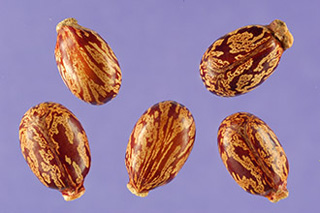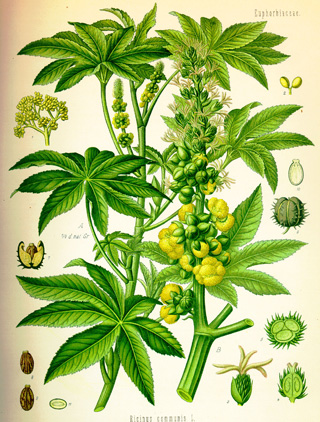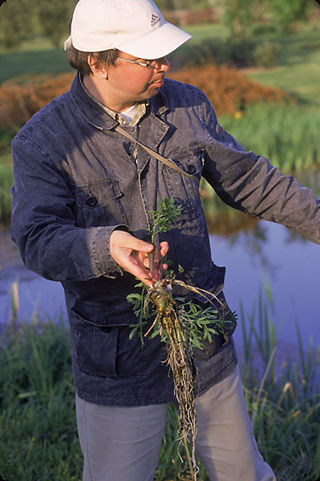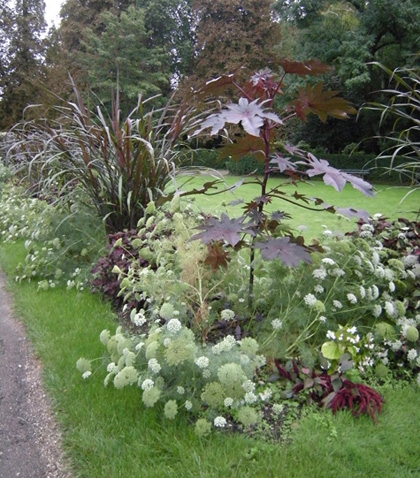Human Flower Project
Pick Your Poison
Allen Bush introduces us to plants that fomented the Iraq War and stopped the heart of Socrates. Proceed with caution.

Seeds of Castor bean, Ricinus communis
Photo: Steve Hurst, USDA-NRCS PLANTS Database
By Allen Bush
The Grateful Dead had a song, beloved by all Deadheads, called “Wheel” with a fateful line: “If the thunder don’t get you, the lightning will.” The warning apparently didn’t reach golfer Lee Trevino and the thought shouldn’t paralyze gardeners. The former P.G.A., U.S. and British Open champion knew how to handle an approaching thunderstorm. Trevino said the safest defense was to hold a two iron in the air. “Even God can’t hit a two iron,” he said.
Relatedly, here’s Donald Rumsfeld, in 2002, a year before going to war in Iraq: “There are known knowns. There are things we know that we know. There are known unknowns. That is to say, there are things that we now know we don’t know. But there are also unknown unknowns. There are things we do not know we don’t know” …a round about way of implying what “Wheel” said succinctly: A threat, even an existential one, can scare the Hell out of a lot of people.
 Ricinus communis
Ricinus communis
Illus. by Franz Eugen Köhler, via wiki
When U.S. troops went to war in Iraq, with the initial premise that they were looking for weapons of mass destruction, one deadly suspect was ricin, a nerve gas made from Castor Bean, Ricinus communis. But of course, the U.S. came-up empty handed in Iraq—meaning no WMDs. Perhaps the world is better off now without Saddam, but there will always be real and present dangers at the garden gate. Walk softly and carry a two iron.
Albert Taylor’s, The Complete Garden (1921) lists plants that will worry you to death—from those that make your eyes water (Hickory and Walnuts) to the deadly poisonous Death Cap mushroom (Amanita phalloides). He writes, “The Darnel (Tares of the Bible, Lolium temulentum), poisons men, dogs, horses and sheep but does not harm cows and pigs.” Thank God, heifers are safe! And I know what to expect from Poison Ivy but didn’t know Primula obconica would make life itchy and miserable. I can’t even think about corn smuts.
The Louisville weather forecast now includes red-eye pollen alerts during the growing season. Mr. T, the actor, who tangled with Sylvester Stallone in Rocky III, and starred in the 80s television show, The A-Team, thought he had a cure for this real – and very present—biological menace. He cut down seventy offending trees in 1987 on his Lake Forest, Illinois, property. Some had been planted early in the century on the advice of the renowned landscape architect Jens Jensen. Mr. T hadn’t stopped to consider the inevitable wind-borne dispersal from neighboring properties. The Bush administration didn’t study intelligence reports very carefully either. As Mr. T liked to say, “Pity the fool.”
And poor Socrates. Too smart for his own good, he was convicted for being an upstart, for corrupting youth with newfangled ideas. The jury sentenced him to death, even though the prosecutor hadn’t sought the death penalty. Socrates nobly took his medicine—a potion of Poison Hemlock – and went to meet his maker.
 Urmas Laansoo with a “plant of interest” in Socrates’ death: Cicuta virosa, a.k.a. Water Hemlock
Urmas Laansoo with a “plant of interest” in Socrates’ death: Cicuta virosa, a.k.a. Water Hemlock
Photo: Allen Bush
Urmas Laansoo, a botanist on the education staff at the Tallinn Botanic Garden in Estonia, once pointed-out a deadly Queen Anne’s Lace relative, Cicuta virosa, growing in a garden. Urmas referred to Circuta virosa as “Poison Hemlock.”
He said it induced Socrates’ hideously convulsive death, but that didn’t square with the gentler demise I’d always imagined. A species growing so far north of the Mediterranean wasn’t out of the question, and I didn’t doubt the very knowledgeable Urmas, but later I asked John Hale what he knew. Hale is a Greek scholar, archaeologist, and Director of Liberal Studies at the University of Louisville. (John recently discovered the Oracles at Delphi, who were sitting in enclosed basement rooms doing the vital work of visionaries, had been huffing mildly hallucinogenic ethylene pouring from intersecting tectonic faults that just so happened to be located smack-dab beneath the temple. This no doubt affected fortune telling.)
Hale wasn’t sure what to make of the Poison Hemlock species but was skeptical of the alleged nasty neurological death. “Have you read Plato’s account of the death of Socrates described by Phaedo in 399 B.C.?” he asked. I had not. But I do know that Cicuta virosa, a.k.a. Water Hemlock, doesn’t grow in Greece.
No offense to Urmas, it is widely presumed that Socrates’ poison came from Conium maculatum, a wide ranging biennial species of the carrot family, native in Greece and throughout most of Europe except colder northern parts. (The species is called Devil’s Porridge in Ireland). Having spread with circumboreal vengeance, it now can be found from Tenerife to Tierra del Fuego. This “Poison Hemlock” grows in temperate parts of North Africa and Asia and has naturalized throughout most of North America, too. Conium maculatum has been widely branded as a noxious weed and occasionally worse—as an invasive marauder. In spite of its demeritorious reputation, it is a very pretty species with finely divided dark green foliage, white flowers like Queen Anne’s Lace and purple-spotted hollow stems. Please, don’t mistake it for close relatives—fennel or parsnip.

The Death of Socrates (1789)
Jacques-Louis David
Phaedo: “…and the man who gave him the poison now and then looked at his feet and legs; and after a while he pressed his foot hard, and then asked him if he could feel; and he said, No; and then his leg, and so upwards and upwards, and showed us that he was cold and stiff. And then he felt then himself and said: When the poison reaches the heart, that will be the end. He was beginning to grow cold about the groin, when he uncovered his face, for he had covered himself up, and said (they were his last words) –he said: ‘Crito, we owe a cock to Asclepius. Be sure to pay the debt.’”
Cornell University has a good website with lists of poisonous plants—some were new to me. I didn’t know buckeyes, Lily of the Valley, Daphne, Bleeding Hearts, Iris, Cardinal Flower or Wisteria could be so worrisome. Have a look: Plants Poisonous to Livestock and Other Animals (“other animals” being those who have read this far)
Ricinus communis is rich in oils used medicinally—for Castor Oil—and has been used also as a lubricant and in the manufacture of plastics and paints. Herodotus wrote about lighting lamps with Castor oil in 4th-century-B.C. Egypt, and seeds have been found there in ancient tombs. The plant’s origin stretched from Africa to India, but it has naturalized elsewhere in warmer climates. The common name, Castor Bean, may have come from Jamaica where it was misidentified for looking like the Chaste Tree, Vitex angus-castus.

Castor bean (Ricinus communis) looking hearty in Dijon, France
Photo: Allen Bush
Though the species typically has green leaves, the most popular commercial Castor Bean seed strain is the red leaf, ‘Carmencita.’ ‘New Zealand Purple’ has still darker leaves. I don’t plant these seeds outdoors until mid-late May when the ground has finally warmed in Kentucky. Volunteer seedlings sometimes pop-up in early June. The seed coats are hard and can be softened a bit—to speed-up germination—with an overnight soak in a glass of water, and then sown. (But stop for a moment before sowing to admire these marvelously speckled – and danger laden – seeds.) If you want to get a jump, you can start them indoors a few weeks earlier. Germination begins in 2-3 weeks. Once the plants reach four feet, it might help to stake them because they can be toppled by a passing thunderstorm. Castor Beans will grow anywhere from five to twelve feet tall depending on whether they get watered in dry spells, but they’ll be flattened by hard frost. In tropical climates, they can reach twenty-five feet or more.
The large 18 – 24” wide decorative star-shaped leaves on long stems (leaf petioles) can be used in floral arrangements, too. They look great, tucked around the base of large vases with long stems of cut sunflowers, as the centerpiece. And, surprisingly, the bold Castor Bean leaves stay fresh for five days or longer.
I’ve grown Castor Bean for years but urge caution if you’ve got toddlers, grazing pets or possible Russian agents living down the street who might have reason to poke you with an umbrella tip loaded with a ricin dart. Georgi Markov, the Bulgarian dissident, got stuck with one in London in 1978—never saw it coming. Met a bad end. (Ricin is made only from the Castor Bean seed coat and not from the embryo. So you can pick-off the seed pods at an early stage before they get hard and spiny. Other plant parts are poisonous but apparently to a lesser extent.)
I’ve seen Castor Bean plants growing abundantly (code for: like weeds) in moist ditches in Baja, Mexico. And I also spotted very happy-looking, well behaved accent plants last summer just few blocks from the Capitol in Washington, D.C. (Do me a favor: Don’t alert Homeland Security. It’s bad enough walking through airport screening imagining the world a safer place just because I’m barefoot.)
Comments
Intrigued by reference to Jamaica (my birth place), I googled castor bean and Jamaica and found numerous references to bio-diesel production and dry skin treatment:
” Castor beans for bio-diesel production – Enthusiasts propose mass cultivation to cut fuel cost” (Jamaica Gleaner News – http://www.jamaica-gleaner.com/gleaner/20070810/business/business1.html)
Jamaican Black Castor Oil (http://www.kaysahai.com/oljacaoiltr.html and www.honeyfig.com/en/products/shop_brand/Jamaician_Black_Castor_Oil/p17028106.html)
Judy, corn smuts sound so wonderfully vulgar but thank you for pointing-out how delicious the fungus is. And, Jamaica, thanks for the links. There are so many interesting bio-fuel options but how many double for skin care?


Don’t worry about corn smut, just eat it! Known as huitlacoche in Mexico it is a difficult-to-obtain ingredient here in the USA. Oh, it turns up in corn fields, but can you imagine sauntering up to a roadside farm stand and asking for it? I have one place that will let me know when it turns up in their fields. If I’m lucky I can get some before the teenagers who help harvest each morning use the cobs of silvery outsize kernels to smack each other with, just to see the black spores explode around. The only other edible smut grows on rice. And after all, smuts are really just a funky kind of delicious, edible fungi.
Judy